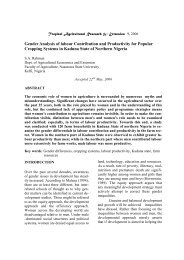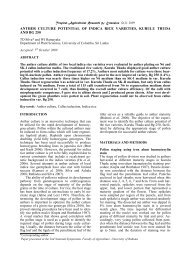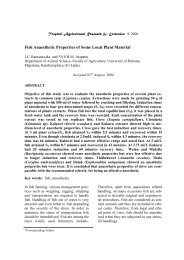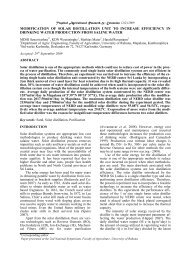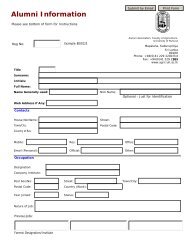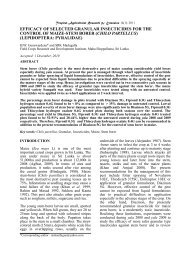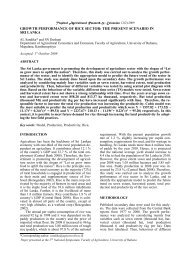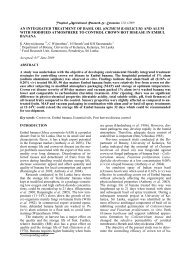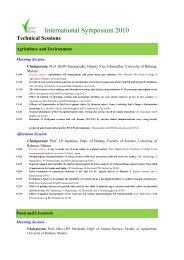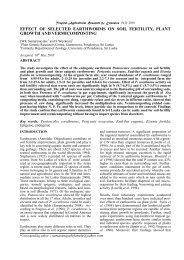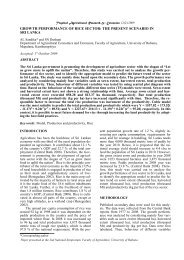salacia reticulata wight - Sri Lanka Journals Online
salacia reticulata wight - Sri Lanka Journals Online
salacia reticulata wight - Sri Lanka Journals Online
Create successful ePaper yourself
Turn your PDF publications into a flip-book with our unique Google optimized e-Paper software.
Tropical Agricultural Research & Extension 13(2): 2010SALACIA RETICULATA WIGHT: A REVIEW OF BOTANY, PHYTOCHEMISTRY ANDPHARMACOLOGYKKIU Arunakumara* and S SubasingheDepartment of Crop Science, Faculty of Agriculture, University of Ruhuna, Mapalana, Kamburupitiya, <strong>Sri</strong><strong>Lanka</strong>Accepted: 05 April 2010ABSTRACTSalacia <strong>reticulata</strong> is a large woody climbing shrub naturally found in <strong>Sri</strong> <strong>Lanka</strong> and Southern region ofIndia. It is widely used in treating diabetes, a chronic disorder in metabolism of carbohydrates, proteinsand fat due to absolute or relative deficiency of insulin secretion with/without varying degree of insulinresistance. The decoction of S. <strong>reticulata</strong> roots is also used in the treatment of gonorrhea, rheumatism,skin diseases, haemorrhoids, itching and swelling, asthma, thirst, amenorrhea and dysmenorrheal.Presence of mangiferin (a xanthone from the roots), kotalanol and salacinol (from the roots and stems)have been identified as the antidiabetic principles of S. <strong>reticulata</strong>. Chemical constituents such as 1,3-diketones, dulcitol and leucopelargonidin, iguesterin, epicatechin, phlobatannin and glycosidal tannins,triterpenes, and 30-hydroxy-20(30) dihydroisoiguesterin, hydroxyferruginol, lambertic acid, kotalagenin16-acetate, 26-hydroxy-1,3-friedelanedione, maytenfolic acid have also been detected in the roots ofS. <strong>reticulata</strong>. The antidiabetic property of Salacia is basically attributed to the inhibitory activity of intestinalenzymes (α-glucosidase and α-amylase). Inhibition of intestinal enzymes delays glucose absorptioninto the blood and suppresses postprandial hyperglycemia, resulting in improved glycemic control.Furthermore, mangiferin has been reported to inhibit aldose reductase activity delaying the onset orprogression of diabetic complications. Though diabetes has now become an epidemic affecting millionsof people worldwide, neither insulin nor other modern pharmaceuticals has been shown to modify thecourse of diabetic complications mainly due to the multifactorial basis that involves both genetic andenvironmental risk factors. Therefore, effort is being devoted to find new therapeutics aimed at multipletargets, which has become a new paradigm in drug discovery. In this context, the discoveries on S.<strong>reticulata</strong> have lead to increase the consumption of the species across the world and it has now become asubject of broad studies for diabetes management.Key words: Salacia <strong>reticulata</strong>, Mangiferin, Kotalanol, Salacinol, DiabetesINTRODUCTIONMedicinal plants are an important element of theindigenous medical systems in <strong>Sri</strong> <strong>Lanka</strong>, whereabout 35 % of the population, even at present, dependson traditional systems of medical care (Smithet al. 2006). The <strong>Sri</strong> <strong>Lanka</strong>ns appeared to have developeda system whereby they select and continueto use plants that they find the most effective forhealth care purposes. Out of 1,414 medicinal plantspecies available in <strong>Sri</strong> <strong>Lanka</strong>, about 250 speciesare commonly used, while 50 species are heavilyused (Pushpakumara et al. 2002). Despite the countryis blessed with a rich diversity of medicinalplants, commercial exploitation of the importantspecies is yet to be developed. Some of the longreputed <strong>Sri</strong> <strong>Lanka</strong>n species have however been extensivelyinvestigated in other countries and subjectof several publications even with no reference to<strong>Sri</strong> <strong>Lanka</strong>n participation. The recent example ofKothala himbatu (Salacia <strong>reticulata</strong>), a specieswidely known for its antidiabetic properties hasbeen investigated in Japan and the United Statesand patented (Pushpakumara et al. 2002). Thoughextensively investigated, it is unlikely that any*Corresponding author: kkiuaruna@crop.ruh.ac.lkcommercial exploitation of their discoveries willresult in the sharing of benefits with <strong>Sri</strong> <strong>Lanka</strong>. Diabeteshas now become an epidemic affecting millionsof people worldwide. However, neither insulinnor other modern pharmaceuticals has beenshown to modify the course of diabetic complicationsmainly due to the multifactorial basis that involvesboth genetic and environmental risk factors.Therefore, new therapeutics aimed at multiple targetshave been extensively investidated. In this context,the discoveries on S. <strong>reticulata</strong> have lead toincrease the consumption of the species across theworld and it has now become a subject of broadstudies for diabetes management. In order to meetthe ever increasing demand, commercial exploitationof the species simultaneously with the scientificinvestigations is of paramount important. Thepresent paper reviewed botany, uses, phytochemistryand pharmacology of Kothala himbatu (S. <strong>reticulata</strong>).MEDICINAL PLANTS AND DIABETESDiabetes is a chronic disorder in metabolism of carbohydrates,proteins and fat due to absolute or rela-
42KKIU ARUNAKUMARA & S SUBASINGHE : A REVIEW OF SALACIA RETICULATAtive deficiency of insulin secretion with/withoutvarying degree of insulin resistance (Barar 2000;Yoshino et al. 2009). It has now become an epidemicaffecting millions of people worldwide(Torben 2002) and the World Health Organizationpredicts that the number of people affecting diabetesmay increase several fold in the near future. Diabetescan be defined as a disease where the bodyeither produces little insulin/ceases to produce insulin,or becomes progressively resistant to its action(Ranjan and Ramanujam 2002). Therefore, the diseasecan be classified into two groups; type I(insulin-dependent) and type II (insulinindependent),which is more common accounting90 % of the diabetic population (Yoshino et al.2009). However, neither insulin nor other modernpharmaceuticals has been shown to modify thecourse of diabetic complications (Grover et al.2002) mainly due to the multifactorial basis thatinvolves both genetic and environmental risk factors(Kaplan and Junien 2000; Loktionov 2003;Reich and Lander 2001). Therefore, effort is beingdevoted to find new therapeutics aimed at multipletargets, which has become a new paradigm in drugdiscovery (Zhang 2005). In this context, it is ofconsiderable interest to note that some natural productscould act on multiple targets to influence multiplebiological activities, producing significantphysiological effects, and thereby providing benefitsthat cannot be obtained with a single compound(Yuhao et al. 2008).Medicinal plants, since times immemorial, havebeen used in virtually all cultures in controlling andpreventing diabetes. As per recent literature, morethan 800 plants are reported to have antidiabeticproperties (Eddouks and Maghrani 2004). Ethnopharmacologicalsurveys indicate that more than1200 plants are used in traditional medicine fortheir alleged hypoglycemic activity (Kesari et al.2007). Hypoglycemic activity of herbal preparationscontaining Salacia species have been reportedin many human studies (Collene et al. 2005; Heacocket al. 2005; Jayawardena et al. 2005; Kajimotoet al. 2000). The roots and stems of S. <strong>reticulata</strong>and the roots of S. oblonga have been extensivelyused for the treatment of rheumatism, gonorrhea,skin diseases, and particularly as a specific remedyfor the initial stages of diabetes in the Ayurvedicsystem of traditional medicine (Matsuda et al.2002; Yoshino et al. 2009). According to Kumar(2000), at least two <strong>Sri</strong> <strong>Lanka</strong>n plants (Salacia <strong>reticulata</strong>and Salacia prinoides) being patented ashaving pharmaceutical potential in producing antidiabeticdrugs. Recently, Salacia species have beenextensively consumed in Japan, the United Statesand other countries as a food supplement for theprevention of obesity and diabetes, as well as beingthe subject of broad studies for diabetes management(He et al. 2009; Yuhao et al. 2008).GEOGRAPHICAL DISTRIBUTION OF SALA-CIA RETICULATASalacia species (e.g. S. oblonga, S. prinoides, S.<strong>reticulata</strong>), known as ‘Ponkoranti’ in Ayurvedicmedicine, are widely distributed in <strong>Sri</strong> <strong>Lanka</strong>, India,China, Vietnam, Malaysia, Indonesia and otherAsian countries, where these species have beenused for thousands of years in traditional medicinesparticularly for the treatment of diabetes (He et al.2009; Yuhao et al. 2008). S. <strong>reticulata</strong> is known tobe distributed in <strong>Sri</strong> <strong>Lanka</strong> and the Southern regionof India (Matsuda et al. 2002). Though rare, thisspecies could also be found in evergreen forests ofWestern Ghats (Ravikumar and Ved 2000). In <strong>Sri</strong><strong>Lanka</strong>, S. <strong>reticulata</strong> is known to be found mainly indry zone, which includes districts such as Hambanthota,Anuradapuraya, Pollonnaruwa, Monaragala,Kurunegala and Puttalm. However, documentaryevidence is lacking on the precise locations inwhich the species is abundantly distributed.BOTANICAL DESCRIPTION AND PROPA-GATIONS. <strong>reticulata</strong> WIGHT (Sinhala: Kothala himbatu) isa large woody climbing shrub belongs to familyHippocrateaceae (Matsuda et al. 2002). The greenishgrey color bark of the plant is smooth, withwhite inside. The average dimension of a leaf is 3 –6 inches long and 1 – 2 inches broad (Sandhu andSingh 2005). They are opposite and elliptic-oblong,base acute, apex abruptly acuminate, margintoothed with minute rounded teeth, leathery, hairless,shiny, lateral nerves about seven pairs, prominentbeneath. S. <strong>reticulata</strong> produces greenish whiteto greenish yellow color flowers as clustered (2-8)in leaf axils (Ravikumar and Ved 2000). Flowersare bisexual, calyx lobes entire, anthers dehiscingtransversely. Fruits are globose, tubercular, pinkishorange when ripe. They contain 1 - 4 seeds(Ravikumar and Ved 2000, Subasinghe et al. 2008).The plant flowers in December under Indian conditions(Sandhu and Singh 2005), whereas in <strong>Sri</strong><strong>Lanka</strong>, flowering starts in late November and seedsare available from March to June (Subasinghe et al.2008).A mature S. <strong>reticulata</strong> plant produces thousands ofseeds per a season (Subasinghe et al. 2008). Thespecies is generally believed to be regenerated onlyby means of seed propagation, however, Kothalahimbatu could also be vegetatively propagated bymeans of stem cuttings (Subasinghe et al. 2008)and root cuttings (Oommen et al. 2000). Sand mediawas found to be good for seed germination in
Tropical Agricultural Research & Extension 13(2): 201043Figure 1. S. <strong>reticulata</strong> fruiting branches with maturepodswhich seeds complete germination within 21 – 30days (Oommen et al. 2000). According toSubasinghe et al. (2008), de-pulped seeds soaked incold water for 24 hrs should be sowed in coir dustmedia to get the highest germination. Seedlingsshould be transplanted into poly-bags and 2-3moths later they are ready for field establishment(Oommen et al. 2000).Though a mature plant produces thousands of seedsper a season, the species is considered to be rareimplying that the viability and/or germination abilityof the seeds are poor. However, laboratory investigationshave confirmed that high germinationpercentage can be obtained by sowing them in coirdust media after pre-soaking in cold water for 24hrs. Therefore, poor regeneration capacity of thespecies might be attributed to the poor moistureavailability of the soil at the time of seed maturity.Low survival ability of seedlings in a dry spellmight be another possible reason for poor regenerationcapacity.USESThe decoction of S. <strong>reticulata</strong> roots is used in thetreatment of itching and swelling, asthma, thirst,amenorrhea and dysmenorrhea (Tissera and Thabrew2001). The roots are acrid, bitter, thermogenic,urinary, astringent, anodyne, anti-inflammatory(Nadkarni 1993). The roots and stem of S. <strong>reticulata</strong>have been widely used in treating diabetes andobesity (Im et al. 2008; Li et al. 2008), gonorrheaand rheumatism (Im et al. 2008), skin diseases (Imet al. 2008; Matsuda et al. 2002) and haemorrhoids(Nadkarni 1993). In addition, the water extracts ofleaves of S. <strong>reticulata</strong> could be beneficial for theprevention of diabetes and obesity as its multipleeffects such as the ability to increase the plasmainsulin level and lower the lipid peroxide level ofFigure 2. S. <strong>reticulata</strong> rooted cuttingthe kidney (Yoshino et al. 2009). In addition to theabove, S. <strong>reticulata</strong> has been widely employed intraditional medicine for treating or preventing severalother disorders, however, published informationon such usages are lacking. It has been noticedthat traditional practitioners appeared to havedeveloped a system whereby they find the mosteffective parts of the plant for different health carepurposes and continue to use them even without theproofs provided by standard clinical trials.PHYTOCHEMISTRYThe constituents of Salacia are numerous and mayvary depending on the species and place of origin(Yuhao et al. 2008). Presence of mangiferin(C 19 H 18 O 11 ), kotalanol (C 12 H 24 O 12 S + 2 ) and salacinol(C 9 H 18 O 9 S + 2 ) have been identified as the antidiabeticprinciples of S. <strong>reticulata</strong> through pharmacologicalstudies (Yoshikawa et al. 1997, 1998; 2001).Other chemical constituents such as 1,3-diketones,dulcitol and leucopelargonidin (a linear iso-mer ofnatural rubber), iguesterin (quinonemethides), epicatechin,phlobatannin and glycosidal tannins,triterpenes, and 30-hydroxy-20(30) dihydroisoiguesterin,hydroxyferruginol, lambertic acid,kotalagenin 16-acetate, 26-hydroxy-1,3-friedelanedione, maytenfolic acid have also beendetected in the root of S. <strong>reticulata</strong> (Premakumaraet al. 1992; Tissera and Thabrew 2001; Yoshikawaet al. 1997, 1998). Though the chemical compositionof different parts of the plant has been extensivelystudied, a complete picture of as to how differentactive ingredients act on physiological processesof the human body is yet to be elaborated.PHARMACOLOGYKajimoto et al. (2000) reported that a double-blindplacebo-controlled study performed in Japan resultedin significantly decreased blood sugar levels in
Tropical Agricultural Research & Extension 13(2): 2010<strong>reticulata</strong> root extract during early or midpregnancyhad no effect on fertility in terms of uterineimplants, implantation index or gestation index(Ratnasooriya et al., 2003). However, as it maypose a considerable threat to successful pregnancy,use of the S. <strong>reticulata</strong> extract should be avoided bywomen with pregnancy complicated by diabetes(Ratnasooriya et al. 2003). Though many toxicologicalstudies carried out with rodents have provedthat little or no adverse effects of S. <strong>reticulata</strong>, clinicaltrials are crucial to further confirm the safety ofthe use of Salacia extracts. The research evidencesuggests that this unique traditional medicine fulfillsa multiple-target strategy in the prevention andtreatment of diabetes and obesity. However, furthermechanistic studies are needed to illustrate as tohow different usage of S. <strong>reticulata</strong> interact withother therapeutic interventions.CONCLUSIONThe antidiabetic property of Salacia <strong>reticulata</strong> hasbeen proved scientifically and it is basically attributedto the inhibitory activity of intestinal enzymes(α-glucosidase and α-amylase). Inhibition ofintestinal enzymes delays glucose absorption intothe blood and suppresses postprandial hyperglycemia,resulting in improved glycemic control. Thefindings have lead to increase the consumption ofthe species across the world and it has now becomea subject of broad studies for diabetes management.Increasing demand, on the other hand, may createextra pressure on natural habitats. Thus systematiccultivation is needed in order to ensure the sustainableutilization and conservation of the species.REFERENCESBarar FSK 2000 Essentials of Pharmacotherapeutics.3 rd ed. S. Chand and Company Ltd: NewDelhi.Collene AL, Hertzler SR, Williams JA and WolfBW 2005 Effects of a nutritional supplementcontaining Salacia oblonga extract and insulinogenicamino acids on postprandial glycemia,insulinemia and breath hydrogen responsesin healthy adults. Nutrition 21: 848–854.Eddouks M and Maghrani M 2004 Phlorizin-likeeffect of Fraxinus excelsior in normal and diabeticrats. J Ethnopharmacol. 9:149-154.Flammang AM, Erexon GL, Mecchi MS and Murli,H 2006 Genotoxicity testing of a Salacia oblongaextract. Food Chem. Toxicol. 44: 1864-1874.Grover JK, Yadav S and Vats V 2002 Medicinalplants of India with anti-diabetic potential.Journal of Ethnopharmacology 81:81-100.45He L, Qi Y, Rong X, Jiang J, Yang Q, Yamahara J,Murray M and Li Y 2009 The Ayurvedic medicineSalacia oblonga attenuates diabetic renalfibrosis in rats: suppression of angiotensin II/AT1 signaling. eCAM 01-13.Heacock PM, Hertzler SR, Williams JA and WolfBW 2005 Effects of a medical food containingan herbal alpha-glucosidase inhibitor on postprandialglycemia and insulinemia in healthyadults. Journal of the American Dietetic Association105: 65–71.Huang TH, Peng GG, Li Q, Yamahara J, RoufogalisBD and Li Y 2006 Salacia oblonga root improvespostprandial hyperlipidemia and hepaticsteatosis in Zucker diabetic fatty rats: activationof PPAR-alpha. Toxicology and Applied Pharmacology210: 225–235.Im R, Mano H, Nakatani S, Shimizu J and Wada M2008 Aqueous extract of Kothala himbatu(Salacia <strong>reticulata</strong>) stems promotes oxygenconsumption and suppresses body fat accumulationin mice. Journal of Health Science 54(6):645-653.Jayawardena MHS, de Alwis NMW, Hettigoda Vand Fernando DJS 2005 A double blind randomisedplacebo controlled cross over study ofa herbal preparation containing Salacia <strong>reticulata</strong>in the treatment of type 2 diabetes. Journalof Ethnopharmacology 97: 215–218.Kajimoto O, Kawamuri S, Shimoda H, KawaharaY, Hirata H and Takahashi T 2000 Effects ofdiet containing Salacia <strong>reticulata</strong> on mild type2 diabetes in humans - A placebo controlledcross over trial. Journal Japanese Society ofNutrition and Food Science 53: 199–205.Kaplan JC and Junien C 2000 Genomics and medicine:an anticipation from Boolean Mendeliangenetics to multifactorial molecular medicine.Comptes rendus de l'Académie des sciences.Série III, Sciences de la vie 323: 1167–1174.Kesari AN, Kesari S, Santosh KS, Rajesh KG andGeeta W 2007 Studies on the glycemic and lipidemiceffect of Murraya koenigii in experimentalanimals. J Ethnopharmacol.112(2):305-311.Kumar V 2000 Systems and national experiencesfor protecting traditional knowledge, innovationsand practices: <strong>Sri</strong> <strong>Lanka</strong>, UNCTAD expertmeting on systems and national experiencesfor protecting traditional knowledge, innovationsand practices, Geneva, 30 October – 1November 2000.Li Y, Huang TH and Yamahara J 2008 Salaciaroot, a unique Ayurvedic medicine, meets multipletargets in diabetes and obesity. Life Sci.82:1045–1049.Li Y, Peng G, Li Q, Wen S, Huang THW, RoufogalisBD and Yamahara J 2004 Salacia oblonga
46KKIU ARUNAKUMARA & S SUBASINGHE : A REVIEW OF SALACIA RETICULATAimproves cardiac fibrosis and inhibits postprandialhyperglycemia in obese Zucker rats. LifeSciences 75: 1735–1746.Loktionov A 2003 Common gene polymorphismsand nutrition: emerging links with pathogenesisof multifactorial chronic diseases. Journal ofNutritional Biochemistry 14: 426–451.Matsuda H, Murakami T, Yashiro K, Yamahara Jand Yoshikawa M 1999 Antidiabetic principlesof natural medicines. IV. Aldose reductase andqlpha-glucosidase inhibitors from the roots ofSalacia oblonga Wall. (Celastraceae): structureof a new friedelane-type triterpene, kotalagenin16-acetate. Chem. Pharm. Bull. 47:1725–1729.Matsuda H, Morikawa T and Yoshikawa M 2002Antidiabetogenic constituents from several naturalmedicines. Pure Appl. Chem. 74(7): 1301–1308.Miura T, Iwamoto N, Kato MJ, Ichiki H, Kubo M,Komatsu Y, Ishida T, Okada M and TanigawaK 2001 The suppressive effect of mangiferinwith exercise on blood lipids in type 2 diabetes.Biological and Pharmaceutical Bulletin 24:1091–1092.Nadkarni KM 1993 The Indian Materia Medica.Popular prakashan Pvt. Ltd., Bombay 1: 1089.Oommen S, Vend DK and Krishnan R 2000 TropicalIndian Medicinal Plants: Propagation Methods.FRLHT, Bangalore. P. 351.Premakumara GAS, Ratnasooriya WD, BalasubramaniumS, Dhanabalasingham B, Fernando,HC, Dias MN, Karunaratne V and GunatilakaAL 1992 Studies on terpenoids and steroids.Part 241. The effect of some natural quinonemethideand 14(15)-enequinonemethidenortriterpenoids on human spermatozoa inutero. Phytochemistry 11: 219-223.Pushpakumara DKNG, Kotagama HB, Marambe B,Gamage G, Silva KAID, Gunaratne LHP, WijesundaraC and Karaluvinne SSDK 2002 Prospectsof pharmaceutical prospecting to financebiodiversity conservation in <strong>Sri</strong> <strong>Lanka</strong>. <strong>Sri</strong><strong>Lanka</strong>n Journal of Agricultural Economics 4(1): 39-71.Ranjan C and Ramanujam R 2002 Diabetes andinsulin resistance associated disorders: Diseaseand the therapy. Curr Sci. 83:1533-1538.Ratnasooriya WD, Jayakody JRAC and PremakumaraGAS 2003 Adverse pregnancy outcomein rats following exposure to a Salacia<strong>reticulata</strong> (Celastraceae) root extract. BrazilianJournal of Medical and Biological Research36: 931-935.Ravikumar K and Ved DK 2000 Illustrated fieldguide-100 Red listed medicinal plants of conservationconcern in Southern India, Pub:Foundation for revitalisation of local healthtraditions, Bangalore, pp. 327-330.Reich DE and Lander ES 2001 On the allelic spectrumof human disease. Trends in Genetics 17:502–510.Sandhu AC and Singh AP 2005 Potential of Ayurvedicherbs in the treatments of dibetes andmellitus. PHCOG. MAG 1(1): 3-6.Serasinghe S, Serasinghe P, Yamazaki H, NishiguchiK, Hombhanje F and Nakanishi S 1990Oral hypoglycemic effect of Salacia <strong>reticulata</strong>in the streptozotocin induced diabetic rat. PhytotherapyResearch 4: 205-206.Shimoda H, Fujimura T, Makino K and YoshijimaK 1999 Safety profile of extractive from trunkof Salacia <strong>reticulata</strong> (Celastraceae). Journal ofthe Food Hygienic Society of Japan 40(3):198-205.Shimoda H, Kawamori S and Kawahara Y 1998Effects of an aqueous extract of Salacia <strong>reticulata</strong>,a useful plant in <strong>Sri</strong> <strong>Lanka</strong>, on postprandialhyperglycemia in rats and humans. NipponEiyo Shokuryo Gakkaishi 151: 279–287.Smith JR, Karunaratne NS and Mahindapala R2006 Rapid inventory of wild medicinal plantpopulations in <strong>Sri</strong> <strong>Lanka</strong>. Biological Concervation132(1): 22-32.Subasinghe S, Arunakumara KKIU, AmarasingheMKTK and Kumarasinghe S 2008 Developmentof Agro-technologycal package for commercialcultivation of bushy type Kothala himbatu(Salacia <strong>reticulata</strong>) plantation for sustainableleaf/stem harvesting. Proceedings of theprogress review meeting of the Ayurveda researchfund, <strong>Sri</strong> <strong>Lanka</strong> 2008. pp. 2-3.Tanimura C, Terada I, Hiramatu K, Ikeda T,Taniguchi M, Kasagi T, Kishino E, Ito T andFujita K 2005 Effect of a mixture of aqueousextract from Salacia <strong>reticulata</strong> (Kotala himbutu)and cyclodextrin on the serum glucose andthe insulin levels in sucrose tolerance test andon serum glucose level changes and gastrointestinaldisorder by massive ingestion. YonagoIgaku Zasshi 56: 85–93.Tissera MHA and Thabrew MI 2001 Medicinalplants and Ayurvedic preparations used in <strong>Sri</strong><strong>Lanka</strong> for the control of diabetes mellitus. Apublication of the Department of Ayurveda,Ministry of Health and Indigenous Medicine,<strong>Sri</strong> <strong>Lanka</strong>.Torben H 2002 Genetics of Type 2 diabetes. CurrSci 83:1477-1482.Williams JA, Choe YS, Noss MJ, Baumgartner, CJand Mustad VA 2007 Extract of Salacia oblongalowers acute glycemia in patients with type2 diabetes. American Journal of Clinical Nutrition86: 124–130.Yoshikawa M, Murkamy T, Shimada H, YamaharaJ, Tanabe G and Muraoka O 1997 Salacinol,potent antidiabetic principle with unique thio-



